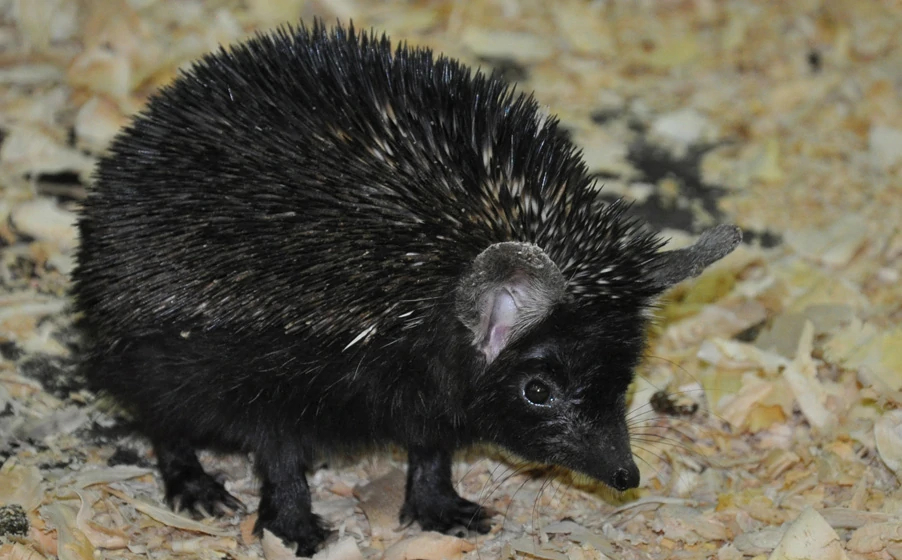If you cannot find the answer you are looking for, please contact us.
Brandt’s hedgehog

First described in 1841 by Brandt. It has a striking dark face and underbelly, contrasting with lighter spines. This species is also known for its agility and ability to climb over rocky terrain.
Taxonomy
| Kingdom: | Animalia |
| Phylum: | Chordata |
| Class: | Mammalia |
| Order: | Eulipotyphla |
| Family: | Erinaceidae |
| Genus: | Paraechinus |
| Species: | Paraechinus hypomelas |
Natural range & habitat
Brandt’s Hedgehog is native to parts of the Middle East and Central Asia, with a range that includes Iran, Afghanistan, Pakistan, and parts of Turkmenistan. It inhabits arid and semi-arid regions, including rocky deserts, scrublands, and dry mountain slopes. The species is adapted to environments with sparse vegetation, loose or stony soils, and extreme temperature fluctuations between day and night. It is often associated with areas that provide natural shelter, such as rock crevices, abandoned burrows, or dense shrubs. Although it prefers wild, undisturbed habitats, it can sometimes be found near cultivated land or rural settlements if suitable foraging opportunities exist. Seasonal activity patterns may vary by region depending on local climate conditions.
Physical traits
Brandt’s Hedgehog is a small to medium-sized species, with a body length generally between 22 and 27 centimeters and an adult weight ranging from 400 to 900 grams, depending on season and condition. Its spines are pale at the base with dark tips, giving a mottled appearance that provides camouflage in rocky environments. The most distinctive physical feature is the facial mask: dark fur covers the face and forehead, contrasting sharply with the lighter spines and underbody fur. The underbelly fur is usually dark brown to black, unlike the pale coloration of many other hedgehogs. The ears are relatively large and rounded, aiding in heat dissipation and possibly enhancing hearing for predator detection in open habitats. The snout is long and pointed, and the limbs are well-muscled for digging. There is little sexual dimorphism beyond minor size differences.
Behavior & lifestyle
Brandt’s Hedgehog is nocturnal and solitary, emerging after sunset to forage and returning to shelter before dawn. During the day, it rests in self-dug burrows, under rocks, or within dense vegetation. It is highly adapted to hot, dry climates and can tolerate significant temperature fluctuations. In the hottest and driest periods, it may enter short-term aestivation to conserve water and energy. Unlike temperate hedgehogs, it generally does not undergo prolonged hibernation, though in colder regions of its range it may enter a dormant state during winter. It is a capable climber and digger, behaviors which help it escape predators and find food. Home ranges are influenced by prey availability, and the hedgehog may travel significant distances each night in search of insects.
Communication
Communication in Brandt’s Hedgehog is primarily through scent marking, which is used to signal territory and reproductive status. Scent glands, likely located in the anal region, play a role in chemical signaling, although the specifics have not been extensively studied for this species. Acoustic communication includes hissing, grunting, and snorting, particularly during mating interactions or when confronted by threats. Postural cues, such as curling into a ball with spines erect, are used defensively. Self-anointing behavior has not been formally recorded in this species but is expected to occur, as it is common across the Erinaceidae family.
Diet in the wild
Brandt’s Hedgehog is an opportunistic insectivore, feeding mainly on beetles, grasshoppers, ants, and other ground-dwelling invertebrates. It may also consume small vertebrates such as lizards, frogs, or rodents, as well as bird eggs when accessible. In dry habitats where invertebrate prey is less abundant, it may supplement its diet with plant matter, including seeds or fruit, though this forms a small proportion of its overall intake. Carrion is occasionally eaten, particularly in resource-scarce periods. It obtains most of its water from food, an important adaptation for survival in arid environments.
Reproduction & life cycle
Breeding in Brandt’s Hedgehog generally occurs in spring and early summer, with timing influenced by climate and food availability. Mating behavior is believed to involve circling, vocalizations, and scent-based cues, as seen in related species. Gestation is estimated at 30 to 40 days, and females give birth to litters of between two and six hoglets. The young are born blind and with soft spines, which harden within a few days. Eyes open after approximately two weeks, and weaning occurs around four to six weeks of age. Juveniles disperse soon after independence. Sexual maturity is typically reached within the first year, and the average lifespan in the wild is estimated at three to five years, though some may live longer in protected environments.
Threats & conservation status
Brandt’s Hedgehog is currently listed as Least Concern by the IUCN, as it has a wide range and is thought to have a stable population overall. However, localized threats exist, including habitat loss due to agricultural expansion, overgrazing by livestock, and infrastructure development. Road mortality is a risk in regions where roads fragment suitable habitat. The use of pesticides can reduce prey abundance and potentially cause secondary poisoning. In some parts of its range, it may be hunted or killed due to local superstitions or for use in traditional medicine. Climate change could further affect its distribution and food resources, though no long-term impact studies have been conducted.lorem ipsum
This species in captivity
Brandt’s Hedgehog is rarely kept in captivity and is not a common pet species. It has occasionally been maintained in local wildlife rescue facilities or in zoological collections within its range for educational purposes. Captive husbandry requires warm, dry conditions, hiding spaces, and a diet high in live insects to match its natural feeding habits. Stress from frequent handling is a concern, as the species is naturally shy and adapted to wide-ranging nocturnal activity. There are no known coordinated captive breeding programs, and conservation efforts focus primarily on habitat protection in the wild.
